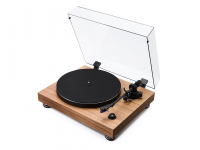
Having exploded in popularity over the past five years or so, the headphone market has become a breeding ground for innovative products, clever design and, most importantly, brilliant sound quality from manufacturers old and new…
So whilst the likes of Sennheiser, AKG and Grado continue to refine their craft, building upon their many decades in the business, the newer kids on the block – companies like Audeze, and today’s subject, Oppo – are also making top-notch equipment that belies the relatively short time they’ve spent in the industry.
Oppo started out life as a manufacturer of high-end DVD and later Blu-Ray players in 2004, moving into headphones and their matching amplifiers more recently. The PM-1 headphones and HA-1 amplifier represent the pinnacle of Oppo’s products, perfectly showing off their credentials as a manufacturer of high-end, but great value, hardware.
That impression is firmly planted even before reaching the unboxing stage with this pair! The PM-1 headphones arrived triple-boxed, with their beautifully polished wooden storage case the final stage in this Russian doll-style setup. Sure, it’s just a case, and it won’t affect the performance in any way, but it’s a lovely touch, and it really lets you know what you’re dealing with. The HA-1 was equally well packaged, but as it’s likely to stay set up rather than tucked away, sturdy cardboard and polystyrene is used instead. Once both are out of their respective boxes, things only get more impressive.
Starting with the PM-1, Oppo have designed a gorgeous set of headphones. Their planar-magnetic drivers are housed in a brushed metal frame, with natural latex ear cushions that perfectly cup the user’s ears and proved to be extremely comfortable and cool around the ears over long use. The headband and the rest of the earpad housing are finished in lambskin, and again, their feel and finish are spot on. Velour pads are also included, and these can be switched out easily according to preference.
The HA-1 is immediately striking in its size. For a headphone amplifier it is pretty considerable: think shoe box size, rather than the palm-of-your-hand style designs of other amplifiers. The reasons for this are all easily justified. Taking a look under the lid (or via pictures on the Oppo website if you don’t want to invalidate the warranty!) shows the Oppo to be packing in an enormous toroidal power supply. This cleanest of transformers allows the HA-1 to kick out up to 3500mw of power – a huge amount for headphone use. What this guarantees is that whatever the headphones you decide to use with this amp, you’re going to be able to drive them to the best of their abilities. To ensure that higher sensitivity headphones can be used with damaging them, a high and low gain option is switchable in the menu.

Elsewhere, the HA-1 has plenty more to talk about. The front of the unit is dominated by a 4.3 colour display. This is the heart of controlling the system, giving a visual indicator of input selection, menu changes and volume. Most impressively, when music is playing back the HA-1 has the option to display either a spectrum or VU meters – a very geeky touch that was hugely appreciated! Around the back, the HA-1 has a wealth of connections, and given the inclusion of an onboard DAC, this is unsurprising.
Choosing to go with the ESS Sabre32 DAC chip (also used in award-winners such as the Audiolab M-DAC), the HA-1 is capable of playing back files of up to 384kHz as well as DSD256 over its USB socket. An optical, coaxial and AES/EBU connection are also fitted for hooking up to more traditional hi-fi components. For analogue sources, a set of phono inputs and XLR inputs are supplied, and the amplifier can run in both balanced and unbalanced operation at the headphone end.
There’s plenty more that can be said about both components but, ultimately, it’s how they perform sonically that interests us most. Our demo units were given a thorough running in before proper listening. Playback was performed from a laptop via USB, from a CD player via the XLR sockets and from SONOS using a coaxial connection.
The PM-1 headphones seemed to share a lot of the traits of other planar-magnetic designs I’ve listened to – such as the Audeze EL8 – and this is no bad thing. More info can be found here on the technology. Through the HA-1, I found the PM-1 to offer a tonally rich performance, capable of digging out plenty of detail, but with a focus more on the texture of sounds rather than microscopic detail retrieval, and a focused, tight performance rather than widescreen soundstaging and instrument separation.

PM-1 Headphones
Birch Tree, the latest single by the British band Foals, gave the Oppo duo a chance to show what they can do. The track is an early taste of Summer sunshine, with frontman Yannis Philippakis’ wistful vocal sitting atop more great work from Foals fantastic rhythm section. That rhythm section held plenty of weight through the Oppo‘s, with the drums in particular having a real heft to them. Most importantly for me, the song sounded like a band performance rather than isolating all of the performers completely. Instrument separation was very good, but the soundstage was kept tight enough to really let the groove of the track do its thing, something that the Sennheiser HD800 were less focused on.
The Oppo‘s could do scale and drama well when needed, too. Being an old-school gaming nerd, I used one of my favourite test albums – Distant Worlds II: more music from Final Fantasy – to test how large-scale orchestra performances were handled. Composer Nobuo Uematsu is video game soundtrack royalty, and these recordings by the Royal Stockholm Philharmonic Orchestra do his work justice and then some. A Hi-Res recording in above-CD quality, it’s a gorgeous listen even if you’ve no interest in the games the songs themselves are from. Main Theme from Final Fantasy VII is the highlight for me, and the track’s beautiful transitions from melancholy strings to the pomp of the closing stages sounded truly fantastic through the Oppo pair. Here, importantly, soundstaging and separation did widen as needed, and the tone and timbre of the instruments still had the richness and texture of the earlier pop tracks. Magnificent stuff.
Tested in isolation or as a pair, the Oppo’s were fantastic hi-fi components. Both have huge plus points that would see them work by themselves or with other products, but as a pair, they truly excelled. At their price point they offer a great alternative to the warts-and-all performance of something like the Sennheiser HD800, digging up fantastic levels of details, but giving a much more rounded and holistic approach to the music. Fans of all genres will find something to love here. Well done, Oppo.
Author – Chris, Liverpool store





